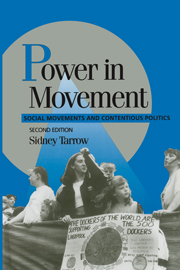Book contents
- Frontmatter
- Contents
- List of Figures
- Preface
- Acknowledgments
- Introduction
- 1 Contentious Politics and Social Movements
- PART 1 THE BIRTH OF THE MODERN SOCIAL MOVEMENT
- PART II FROM CONTENTION TO SOCIAL MOVEMENTS
- 5 Political Opportunities and Constraints
- 6 Acting Contentiously
- 7 Framing Contention
- 8 Mobilizing Structures and Contentious Politics
- PART III THE DYNAMICS OF MOVEMENT
- Conclusion: The Future of Social Movements
- Notes
- Sources
- Index
- CAMBRIDGE STUDIES IN COMPARATIVE POLITICS
7 - Framing Contention
Published online by Cambridge University Press: 05 June 2012
- Frontmatter
- Contents
- List of Figures
- Preface
- Acknowledgments
- Introduction
- 1 Contentious Politics and Social Movements
- PART 1 THE BIRTH OF THE MODERN SOCIAL MOVEMENT
- PART II FROM CONTENTION TO SOCIAL MOVEMENTS
- 5 Political Opportunities and Constraints
- 6 Acting Contentiously
- 7 Framing Contention
- 8 Mobilizing Structures and Contentious Politics
- PART III THE DYNAMICS OF MOVEMENT
- Conclusion: The Future of Social Movements
- Notes
- Sources
- Index
- CAMBRIDGE STUDIES IN COMPARATIVE POLITICS
Summary
In Year V of the French Revolution, the commissioner of the revolutionary executive power in Grenoble wrote:
It is a contravention of the constitutional charter … to insult, provoke, or threaten citizens because of their choice of clothing. Let taste and propriety preside over your dress; never turn away from agreeable simplicity … Renounce these signs of rallying, these costumes of revolt, which are the uniforms of an enemy army.
The commissioner was in a position to know. In the decade in which he wrote, the French produced the first systematic attempts to reshape political culture around new forms of dress, holidays, salutations, public works, and monuments. As the revolution spread, so did its symbols. Austere dress marked off republicans from aristocratic display (Hunt 1984: 75–6); supporters of the Revolution would challenge citizens who dared to be seen on the street in elegant dress; even the king had a Phrygian bonnet stuck on his head before he lost it after the failure of his flight to Varennes (Schama 1989: 603–4).
Attempts at symbolic mobilization accompany every modern social movement, from the donning of simple military tunics by the Russian and Chinese Communists, to the pagan glitter of the Italian Fascist hierarchs, to the simple khaki cloth of Indian nationalists, and the scruffy beards of Latin American guerrileros. Since social movements attempt to replace “a dominant belief system that legitimizes the status quo with an alternative mobilizing belief system that supports collective action for change” (Gamson, Fireman, and Rytina 1982: 15), movement leaders proffer the symbols of revolt to gain support and mark themselves off from opponents.
Information
- Type
- Chapter
- Information
- Power in MovementSocial Movements and Contentious Politics, pp. 106 - 122Publisher: Cambridge University PressPrint publication year: 1998
